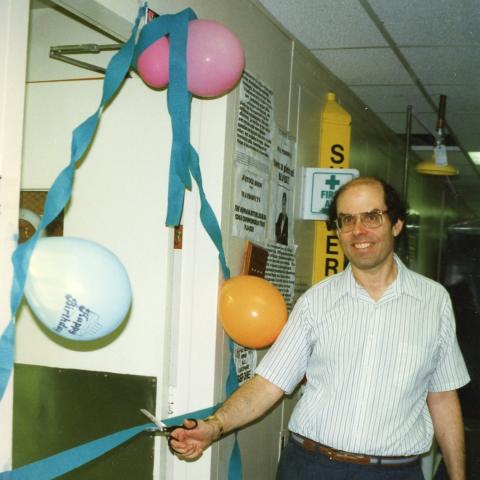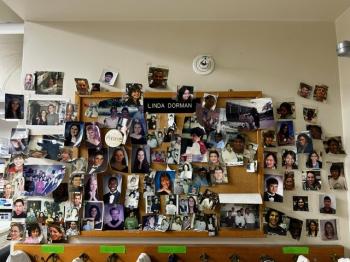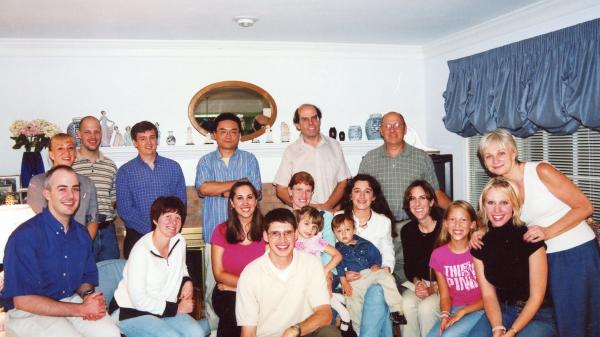
Howard A. Young, Ph.D., cutting the ribbon to celebrate the opening of his lab in the 1980s.
For over 40 years, Howard A. Young, Ph.D., has contributed to understanding cytokine gene expression more deeply, specifically interferons and how they contribute to chronic inflammation and disease. Now, the senior investigator in the Cancer Innovation Laboratory and head of the Cellular and Molecular Immunology Section has announced his retirement.
Young received his B.S. in Microbiology from the University of Massachusetts, Amherst, in 1969, and his Ph.D. in Microbiology and Immunology from the University of Washington in Seattle in 1974. His journey at the NCI began with a postdoctoral position in the Laboratory of Tumor Virus Genetics.
In 1977, he became a senior staff fellow, followed by a move to the NCI Frederick campus to become a Senior Research Scientist in the Molecular Biology of Retroviruses Section. Subsequently, Young spent two years at a local biotech company, Bethesda Research Laboratories, as Head of Technical Services. He then was recruited back to the NCI Frederick campus to join the Biological Response Modifiers Program (BRMP). Young gives immense credit and appreciation to the late Joost “Joe” Oppenheim, M.D., who he felt took a chance on him and greatly helped him succeed as a member of the BRMP.
Young was involved very early on in the characterization and cloning of RAS oncogenes, categorically those that are virally transmitted. These oncogenes have been recognized as a primary driver of cancer metastasis and development.
He became a Senior Staff Scientist in the Laboratory of Molecular Immunoregulation in the late 1980s and eventually the Deputy Chief of the Laboratory of Experimental Immunology from 2006 through 2015. In 2015, he joined the Laboratory of Cancer Immunometabolism which then became the Cancer Innovation Laboratory.
Young’s primary research focuses on the in vivo consequences of chronic interferon-gamma expression (IFN-y). This immunoregulatory protein is expressed in the development of the cellular immune system and the body’s response to infection. Using mouse models, his work helped determine that chronic expression of this gene is integral to the development of lupus-like diseases, anaplastic anemia, biliary cholangitis and ovarian failure syndrome. Manipulation of this signaling pathway continues to be used to develop innovative approaches toward treating inflammatory diseases.
Young also widened research on the IL-22 receptor, which is a cytokine that has been expressed in both the growth of and protection against inflammatory disease. From here, his work focused on the biological significance of forced IL-22 receptor expression and how it was a driving factor in inflammation and tumor development. This was foundational to the development of IL-22 serum screenings for patients with lymphoma, which provide approaches on how to tackle the disease.
Perhaps one of his most palpable strengths as noted by his colleagues is Young’s deep commitment to mentoring the next generation of physician-scientists and building bridges of friendship within. Throughout his decades-long career, Young recognized that science does not exist in a vacuum and that the best progress that can be made is the progress created through collaboration, cooperation and communication across organizations and fields, and he frequently expressed this to his colleagues and mentees.
“Dr. Young never hesitated in introducing me to his more extensive network if necessary, and he never hesitated to support my applications to different training or funding programs. His unique mentoring style encourages independent and critical thinking, which worked well with me,” postdoctoral fellow Enitome Bafor said.
“One example of Dr. Young's dedication to mentoring was his involvement with the Werner H. Kirsten Student Intern Program, which was initiated in Frederick in 1989. From its inception, Dr. Young was a strong proponent of providing experience, direction, and challenges to young high school students interested and considering a career in science,” wrote former coworkers Dr. John Ortaldo and Dr. Robin Winkler-Pickett.
Young has received several awards for his excellence in mentoring including the first recipient of the International Cytokine and Interferon Society (ICIS) Mentorship Award. In addition, the ICIS renamed its Distinguished Service Award as the ICIS Howard A. Young Distinguished Service Award.
Young also held professional memberships ranging from the American Society of Microbiology to the American Association of Immunologists; he served as a newsletter editor for the International Cytokine and Interferon Society and on the editorial boards for the Journal of Biological Chemistry, the Journal of Immunology, Cytokine and Growth Factor Reviews, the Journal of Interferon and Cytokine Research, Cytokine, PeerJ and Frontiers in Immunology.
After his election into the American Academy of Microbiology in 2000, Young went on to become the President of the International Society for Interferon and Cytokine Research, as well as being elected to the Fellow American Association for the Advancement of Science in 2022.
In the following Q&A, Dr. Young speaks on his strengths and his hopes for the future:
Q: What excites you most about the future frontiers of cancer research, both here at NCI and beyond?
A: I think what is going on in Dr. Steven Rosenberg’s lab and those who have now begun to use immunotherapy technologies is exciting. These technologies are working towards making cancer a disease with which people can live, and enabling patients to lead normal lives as a result of these treatments.
Q: Why is mentorship important in the scientific community, and what did it teach you about yourself?
A: I have always considered mentorship to be an important aspect of having a lab at the NIH; we must take part in training the next generation of scientists. Being a mentor taught me that there are no specific rules to be followed, as each person is unique and needs personalized mentoring. It has always been an objective of mine that when someone leaves my lab, they can tell me it was worth this part of their life to have been a member of my lab.
Q: What sort of legacy do you hope you are leaving behind here at NCI/CCR?
A: I am hoping that people will strive to create labs that are surrounded by windows, not mirrors. The ability to interact with so many terrific scientists at the NIH should be a goal of every lab. People here at the NCI are all willing to work with you and help you understand your projects, and that makes it a very special place where I feel privileged to have spent my career.

